National Collaborating Centre for Women's and Children's Health
National Collaborating Centre for Women's and Children's Health
National Collaborating Centre for Women's and Children's Health
You also want an ePaper? Increase the reach of your titles
YUMPU automatically turns print PDFs into web optimized ePapers that Google loves.
4 Physical therapy<br />
(physiotherapy <strong>and</strong>/or<br />
occupational therapy)<br />
Introduction<br />
Children with developmental <strong>and</strong> physical problems due to an upper motor neurone lesion (UMNL)<br />
usually receive physical therapy (that is, physiotherapy <strong>and</strong>/or occupational therapy). Physical therapy<br />
typically starts when developmental concerns first arise or at the time of injury, <strong>and</strong> it continues<br />
throughout childhood <strong>and</strong> into adult life. Physical therapists use a proactive <strong>and</strong> preventative<br />
approach centred on underst<strong>and</strong>ing the causes of the child or young person’s current functional<br />
problems <strong>and</strong> how these impact upon their ability to develop <strong>and</strong> maintain skills <strong>and</strong> participate in<br />
home <strong>and</strong> school life, <strong>and</strong> in the wider community. As well as managing functional problems, physical<br />
therapists have a large educational <strong>and</strong> advisory role, helping children <strong>and</strong> young people <strong>and</strong> their<br />
families or carers underst<strong>and</strong> their conditions <strong>and</strong> prognoses.<br />
Spasticity usually <strong>for</strong>ms one physical feature in a complex movement disorder caused as a result of a<br />
UMNL. Advances in the underst<strong>and</strong>ing of motor learning, neurodevelopment <strong>and</strong> how the child or<br />
young person responds to different situations <strong>and</strong> environmental changes support a functional<br />
approach to therapy, giving greater priority to maximising activity <strong>and</strong> participation in line with the<br />
domains of the World <strong>Health</strong> Organization’s (WHO’s) International Classification of Functioning,<br />
Disability <strong>and</strong> <strong>Health</strong> (ICF) Framework. The ICF Framework includes a version that is specific to<br />
children <strong>and</strong> young people (ICF children <strong>and</strong> youth version). The link between these domains is not<br />
clearly defined but it is recognised that negative <strong>and</strong> compensatory phenomena resulting from a<br />
UMNL (<strong>for</strong> example neurological weakness, poor movement control, abnormal sensation, health<br />
issues <strong>and</strong> reduced fitness <strong>and</strong> body condition) may have a more significant impact on a child or<br />
young person’s ability to participate in everyday life than spasticity alone.<br />
A child or young person’s physical therapy needs, which are usually assessed on an individual basis,<br />
may be complex <strong>and</strong> multifaceted, changing throughout their lifetime as they develop physically <strong>and</strong><br />
cognitively. The severity of the neurological damage, age dem<strong>and</strong>s <strong>and</strong> resulting functional problems<br />
determine physical therapy goals <strong>and</strong> interventions. Physical therapists recognise that a child or<br />
young person’s cognitive ability, personality, health <strong>and</strong> fitness, family situation, comorbidities,<br />
environment <strong>and</strong> social context have a significant impact on activity <strong>and</strong> participation. Many physical<br />
therapy interventions have a wider impact <strong>and</strong> require responsibility to be shared between different<br />
types of healthcare professionals, the child or young person’s family or carers, <strong>and</strong> social care <strong>and</strong><br />
education services.<br />
Physical therapists recognise that movement difficulties in children <strong>and</strong> young people are complicated<br />
by growth <strong>and</strong> the effects of gravity, which can cause increasing secondary compensation effects of<br />
muscle <strong>and</strong> bony de<strong>for</strong>mity. These can result in pain <strong>and</strong> limitation of activity causing reduced quality<br />
of life <strong>and</strong> increased family stress, emotional difficulties <strong>and</strong> care needs. Physical therapists are vital<br />
in recognising <strong>and</strong> managing these limitations, referring on to professional colleagues <strong>for</strong> advice <strong>and</strong><br />
further management where necessary. Physical therapy is used in conjunction with other<br />
interventions, such as oral drugs, botulinum toxin type A (BoNT-A), continuous pump-administered<br />
intrathecal baclofen (CITB), orthopaedic surgery <strong>and</strong> selective dorsal rhizotomy (SDR), to improve<br />
effectiveness <strong>and</strong> aid rehabilitation.<br />
45

















